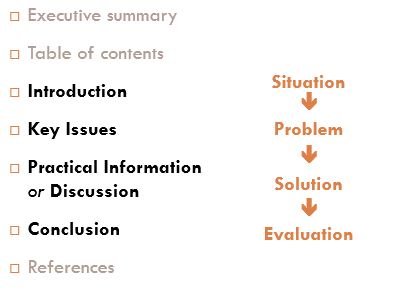Developing an outline using the SPSE framework can be a useful way to begin an approach to your proposal, and might even help you generate ideas and detail.
- Write down the SITUATION today.
- Write down the PROBLEM as you see it.
- Considering the research you have done so far, write down what could be two or three prospective SOLUTIONS for that problem.
- Write down how you intend to EVALUATE those prospective solutions – analyzing research already conducted? Carrying out further research? Conduct experiments? Other options?
SITUATION
- Offer relevant background information on subject, with a focus on the situation today (not ‘throughout time…’)
- Provide a statement or claim that should draw your reader into the text.
- Phrase this situation in a positive light – you will be offering a solution (not complaining about the problem)
- note who is offering the proposal (why you? qualifications? expertise?)
- briefly, address the purpose and scope of the proposal (include a reference to the document which prompted the proposal, if any)
- briefly, outline what is to come – offer a concise description of the contents of the proposal
PROBLEM
- Provide a clear and specific description of the problem – what is your proposed solution going to solve, fix, or improve?
- Begin the transition from positive to practical – there is a problem (a key issue), but it can be resolved, and you are moving to discuss the practical issues involved
- Why bother? provide a concise background and description of the problem
SOLUTION
While your research and your analysis may provide a number of options, you should:
- offer one specific and possible solution (there are likely to be multiple options, but because most proposals tend to be short texts, it is usually preferable to focus on one).
Your proposed solution may be your own or connected to your research. You need to clarify:
- Why have you chosen this solution or approach?
- What evidence can you provide that demonstrates the quality of this solution / approach?
EVALUATION
As your discussion section continues and you move into your conclusion, address:
- How far does your proposed solution work?
- How certain are you that this is the answer?
- How does the language you use reflect the breadth of your solution and confidence in it? Confidence involves clear, persuasive language rather than markers that something is self-evident (like ”obviously” or ”clearly”, which might make readers wonder why the proposal is necessary if its merits are already common knowledge).
- As you move into your conclusion, does your use of language and tone reflect a balanced yet positive attitude towards your solution?

